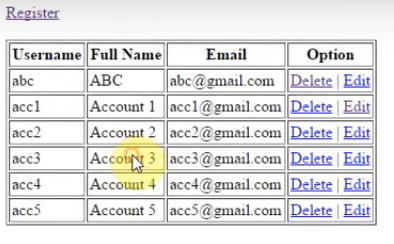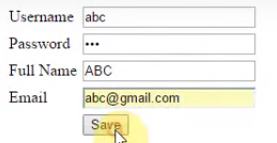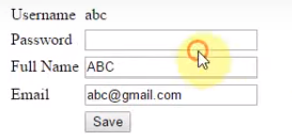Database
Create a new MySQL database named mydemo and execute the SQL code below:
-- phpMyAdmin SQL Dump
-- version 4.1.14
-- http://www.phpmyadmin.net
--
-- Host: 127.0.0.1
-- Generation Time: Jul 29, 2015 at 04:21 AM
-- Server version: 5.6.17
-- PHP Version: 5.5.12
SET SQL_MODE = "NO_AUTO_VALUE_ON_ZERO";
SET time_zone = "+00:00";
/*!40101 SET @OLD_CHARACTER_SET_CLIENT=@@CHARACTER_SET_CLIENT */;
/*!40101 SET @OLD_CHARACTER_SET_RESULTS=@@CHARACTER_SET_RESULTS */;
/*!40101 SET @OLD_COLLATION_CONNECTION=@@COLLATION_CONNECTION */;
/*!40101 SET NAMES utf8 */;
--
-- Database: `mydemo`
--
-- --------------------------------------------------------
--
-- Table structure for table `account`
--
CREATE TABLE IF NOT EXISTS `account` (
`username` varchar(250) COLLATE utf8_unicode_ci NOT NULL,
`password` varchar(250) COLLATE utf8_unicode_ci NOT NULL,
`fullname` varchar(250) COLLATE utf8_unicode_ci NOT NULL,
`email` varchar(250) COLLATE utf8_unicode_ci NOT NULL,
PRIMARY KEY (`username`)
) ENGINE=InnoDB DEFAULT CHARSET=utf8 COLLATE=utf8_unicode_ci;
--
-- Dumping data for table `account`
--
INSERT INTO `account` (`username`, `password`, `fullname`, `email`) VALUES
('abc', '456', 'ABC1111', 'abc1111@gmail.com'),
('acc1', '123', 'Account 1', 'acc1@gmail.com'),
('acc2', '123', 'Account 2', 'acc2@gmail.com'),
('acc3', '123', 'Account 3', 'acc3@gmail.com'),
('acc4', '123', 'Account 4', 'acc4@gmail.com'),
('acc5', '123', 'Account 5', 'acc5@gmail.com');
-- --------------------------------------------------------
--
-- Table structure for table `category`
--
CREATE TABLE IF NOT EXISTS `category` (
`id` int(11) NOT NULL AUTO_INCREMENT,
`name` varchar(250) COLLATE utf8_unicode_ci NOT NULL,
PRIMARY KEY (`id`)
) ENGINE=InnoDB DEFAULT CHARSET=utf8 COLLATE=utf8_unicode_ci AUTO_INCREMENT=4 ;
--
-- Dumping data for table `category`
--
INSERT INTO `category` (`id`, `name`) VALUES
(1, 'Category 1'),
(2, 'Category 2'),
(3, 'Category 3');
-- --------------------------------------------------------
--
-- Table structure for table `orders`
--
CREATE TABLE IF NOT EXISTS `orders` (
`id` int(11) NOT NULL AUTO_INCREMENT,
`name` varchar(250) COLLATE utf8_unicode_ci NOT NULL,
`datecreation` date NOT NULL,
`status` tinyint(1) NOT NULL,
`username` varchar(250) COLLATE utf8_unicode_ci NOT NULL,
PRIMARY KEY (`id`),
KEY `username` (`username`)
) ENGINE=InnoDB DEFAULT CHARSET=utf8 COLLATE=utf8_unicode_ci AUTO_INCREMENT=13 ;
--
-- Dumping data for table `orders`
--
INSERT INTO `orders` (`id`, `name`, `datecreation`, `status`, `username`) VALUES
(1, 'Order 1', '2015-01-24', 0, 'acc1'),
(2, 'Order 2', '2015-01-14', 1, 'acc1'),
(3, 'Order 3', '2015-01-24', 0, 'acc4'),
(4, 'Order 4', '2015-01-29', 0, 'acc4'),
(5, 'Order 5', '2015-01-24', 1, 'acc4'),
(6, 'Order 6', '2015-01-12', 0, 'acc3'),
(7, 'Order 7', '2015-01-24', 1, 'acc3'),
(8, 'Order 8', '2015-01-24', 0, 'acc2'),
(9, 'Order 9', '2015-01-09', 1, 'acc2'),
(11, 'New Order', '2015-07-12', 0, 'acc2'),
(12, 'New Order', '2015-07-12', 0, 'acc2');
-- --------------------------------------------------------
--
-- Table structure for table `ordersdetail`
--
CREATE TABLE IF NOT EXISTS `ordersdetail` (
`productid` int(11) NOT NULL,
`ordersid` int(11) NOT NULL,
`price` decimal(10,0) NOT NULL,
`quantity` int(11) NOT NULL,
PRIMARY KEY (`productid`,`ordersid`),
KEY `mahd` (`ordersid`)
) ENGINE=InnoDB DEFAULT CHARSET=utf8 COLLATE=utf8_unicode_ci;
--
-- Dumping data for table `ordersdetail`
--
INSERT INTO `ordersdetail` (`productid`, `ordersid`, `price`, `quantity`) VALUES
(1, 2, '1000', 1),
(1, 3, '1000', 1),
(1, 4, '1000', 1),
(1, 5, '1000', 1),
(1, 7, '1000', 1),
(1, 8, '1000', 1),
(1, 9, '1000', 1),
(1, 11, '1000', 1),
(1, 12, '1000', 8),
(2, 2, '200', 1),
(2, 4, '200', 1),
(2, 6, '200', 1),
(2, 8, '200', 1),
(2, 12, '200', 12),
(3, 2, '500', 1),
(3, 6, '500', 1),
(7, 12, '520', 4);
-- --------------------------------------------------------
--
-- Table structure for table `product`
--
CREATE TABLE IF NOT EXISTS `product` (
`id` int(11) NOT NULL AUTO_INCREMENT,
`name` varchar(250) COLLATE utf8_unicode_ci NOT NULL,
`price` decimal(10,0) NOT NULL,
`quantity` int(11) NOT NULL,
`description` text COLLATE utf8_unicode_ci NOT NULL,
`photo` varchar(250) COLLATE utf8_unicode_ci NOT NULL,
`categoryid` int(11) NOT NULL,
PRIMARY KEY (`id`),
KEY `categoryid` (`categoryid`)
) ENGINE=InnoDB DEFAULT CHARSET=utf8 COLLATE=utf8_unicode_ci AUTO_INCREMENT=8 ;
--
-- Dumping data for table `product`
--
INSERT INTO `product` (`id`, `name`, `price`, `quantity`, `description`, `photo`, `categoryid`) VALUES
(1, 'Nokia 1', '1000', 2, 'good', 'thumb1.gif', 1),
(2, 'Nokia 2', '200', 5, 'good', 'thumb2.gif', 1),
(3, 'Samsung 1', '500', 8, 'good', 'thumb3.gif', 2),
(4, 'Samsung 2', '500', 8, 'good', 'thumb1.gif', 3),
(5, 'Apple 1', '520', 8, 'good', 'thumb2.gif', 3),
(6, 'Apple 2', '520', 8, 'good', 'thumb2.gif', 3),
(7, 'Apple 3', '520', 8, 'good', 'thumb2.gif', 3);
--
-- Constraints for dumped tables
--
--
-- Constraints for table `orders`
--
ALTER TABLE `orders`
ADD CONSTRAINT `orders_ibfk_1` FOREIGN KEY (`username`) REFERENCES `account` (`username`);
--
-- Constraints for table `ordersdetail`
--
ALTER TABLE `ordersdetail`
ADD CONSTRAINT `ordersdetail_ibfk_1` FOREIGN KEY (`productid`) REFERENCES `product` (`id`),
ADD CONSTRAINT `ordersdetail_ibfk_2` FOREIGN KEY (`ordersid`) REFERENCES `orders` (`id`);
--
-- Constraints for table `product`
--
ALTER TABLE `product`
ADD CONSTRAINT `product_ibfk_1` FOREIGN KEY (`categoryid`) REFERENCES `category` (`id`);
/*!40101 SET CHARACTER_SET_CLIENT=@OLD_CHARACTER_SET_CLIENT */;
/*!40101 SET CHARACTER_SET_RESULTS=@OLD_CHARACTER_SET_RESULTS */;
/*!40101 SET COLLATION_CONNECTION=@OLD_COLLATION_CONNECTION */;
Database Connection
Create PHP file named connect.php. Use PDO connect to demo database with default account:
Username: root
Password:
<?php
$conn = new PDO("mysql:host=localhost;dbname=mydemo", 'root', '');
?>
List All Products
Create PHP file named index.php. This file will list all accounts from the account table and allow to delete the selected account as below:
<?php
require 'database.php';
if(isset($_GET['action']) && $_GET['action']=='delete'){
$stmt = $conn->prepare('delete from account where username = :username');
$stmt->bindValue('username', $_GET['username']);
$stmt->execute();
}
$stmt = $conn->prepare('select * from account');
$stmt->execute();
?>
<a href="register.php">Register</a>
<br>
<br>
<table cellpadding="2" cellspacing="2" border="1">
<tr>
<th>Username</th>
<th>Full Name</th>
<th>Email</th>
<th>Option</th>
</tr>
<?php while($account = $stmt->fetch(PDO::FETCH_OBJ)) { ?>
<tr>
<td><?php echo $account->username; ?></td>
<td><?php echo $account->fullname; ?></td>
<td><?php echo $account->email; ?></td>
<td><a
href="index.php?username=<?php echo $account->username; ?>
&action=delete" onclick="return confirm('Are you sure?')">Delete</a>
| <a href="edit.php?username=<?php echo $account->username; ?>">Edit</a>
</td>
</tr>
<?php } ?>
</table>
Add New Account
Create new PHP file named add.php. This file contains forms for adding new account as below:
<?php
require 'database.php';
if(isset($_POST['save'])) {
$stmt = $conn->prepare('insert into account(username, password, fullname, email)
values(:username, :password, :fullname, :email)');
$stmt->bindValue('username', $_POST['username']);
$stmt->bindValue('password', $_POST['password']);
$stmt->bindValue('fullname', $_POST['fullname']);
$stmt->bindValue('email', $_POST['email']);
$stmt->execute();
header('location:index.php');
}
?>
<form method="post">
<fieldset>
<legend>Account Information</legend>
<table cellpadding="2" cellspacing="2">
<tr>
<td>Username</td>
<td><input type="text" name="username"></td>
</tr>
<tr>
<td>Password</td>
<td><input type="password" name="password"></td>
</tr>
<tr>
<td>Full Name</td>
<td><input type="text" name="fullname"></td>
</tr>
<tr>
<td>Email</td>
<td><input type="text" name="email"></td>
</tr>
<tr>
<td> </td>
<td><input type="submit" name="save" value="Save"></td>
</tr>
</table>
</fieldset>
</form>
Account Updates
Create new PHP file named update.php. This file contains forms allow the user to update account information
<?php
require 'database.php';
if(isset($_POST['save'])) {
// Find account by username
$stmt = $conn->prepare('select * from account where username = :username');
$stmt->bindValue('username', $_POST['username']);
$stmt->execute();
$account = $stmt->fetch(PDO::FETCH_OBJ);
// Update account information
$stmt = $conn->prepare('update account set password = :password,
fullname = :fullname, email = :email where username = :username');
$stmt->bindValue('username', $_POST['username']);
$stmt->bindValue('password', $_POST['password'] == '' ? $account->password : $_POST['password']);
$stmt->bindValue('fullname', $_POST['fullname']);
$stmt->bindValue('email', $_POST['email']);
$stmt->execute();
header('location:index.php');
}
$stmt = $conn->prepare('select * from account where username = :username');
$stmt->bindValue('username', $_GET['username']);
$stmt->execute();
$account = $stmt->fetch(PDO::FETCH_OBJ);
?>
<form method="post">
<fieldset>
<legend>Account Information</legend>
<table cellpadding="2" cellspacing="2">
<tr>
<td>Username</td>
<td><?php echo $account->username; ?>
<input type="hidden" name="username"
value="<?php echo $account->username; ?>"></td>
</tr>
<tr>
<td>Password</td>
<td><input type="password" name="password"></td>
</tr>
<tr>
<td>Full Name</td>
<td><input type="text" name="fullname" value="<?php echo $account->fullname; ?>"></td>
</tr>
<tr>
<td>Email</td>
<td><input type="text" name="email" value="<?php echo $account->email; ?>"></td>
</tr>
<tr>
<td> </td>
<td><input type="submit" name="save" value="Save"></td>
</tr>
</table>
</fieldset>
</form>
Demo
Accounts List Page

Add New Account Page

Edit Account Page

References
I recommend you refer to the books below to learn more about the knowledge in this article:
- Murach’s PHP and MySQL (3rd Edition)
- Learning PHP, MySQL & JavaScript: With jQuery, CSS & HTML5 (Learning Php, Mysql, Javascript, Css & Html5)
- PHP and MySQL Web Development (5th Edition) (Developer’s Library)
- Murach’s MySQL, 2nd Edition
- MySQL (5th Edition) (Developer’s Library)
- PHP Ajax Cookbook


